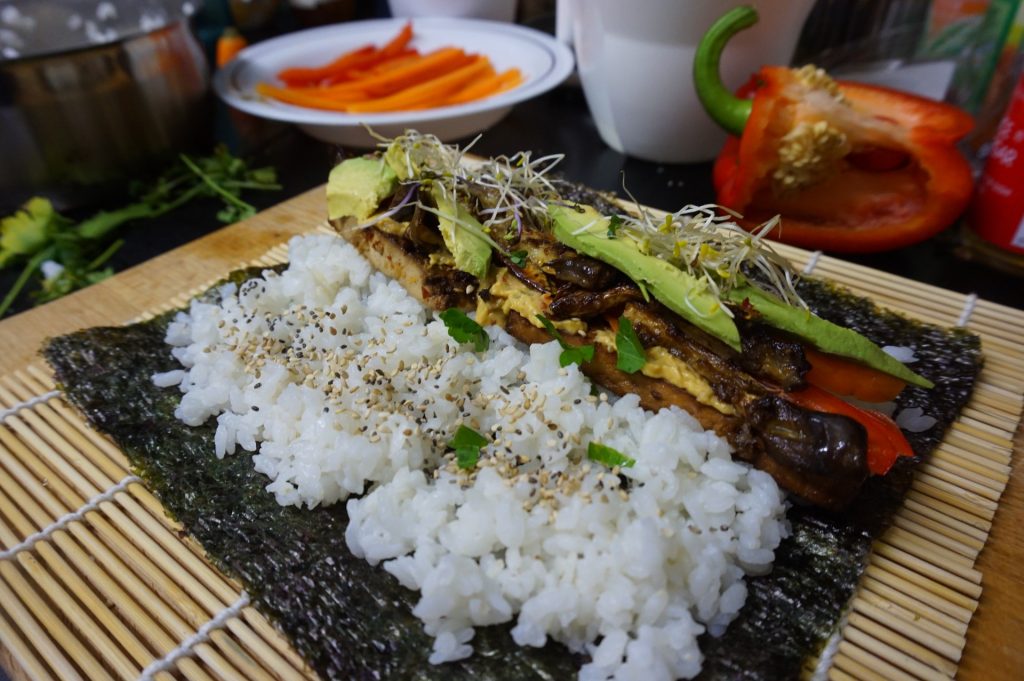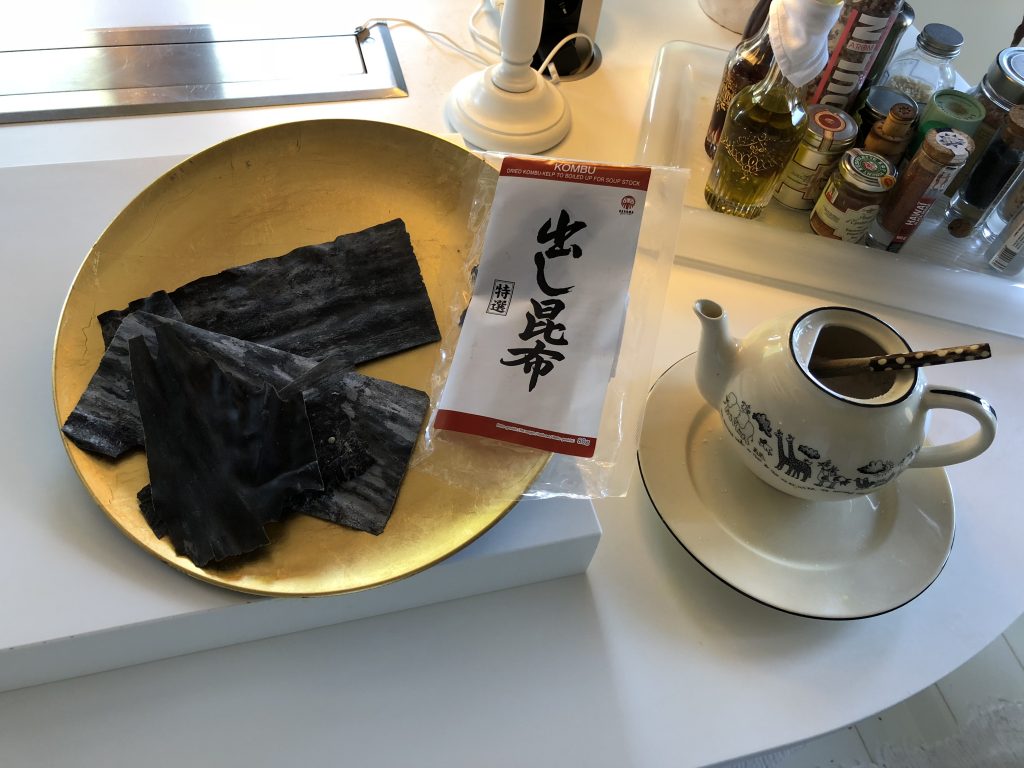Focusing only on sea algae, we see that European legislation has restricted the use of marine macroalgae in the human and animal food to 22 species, based only on consumption records in Europe (see the EU grid below) and not for a question of food safety. We suggest these 10 types of algae that you can easily find in a specialty store so you can enjoy it in your daily dishes at your home.

Nori offered popularity to sushi
Nori is one of the most popular algae in the world for being part of the famous sushi. It is part of the red algae group, but the way it is prepared to be made can give it other shades: purple, black or green. The good appearance for consumption is recognized by the homogeneous form of the thin and dry leaves that must have a bright color in visual contact with the sun. It is rich in iodine, calcium, iron, among other minerals and a quarter of its contents are proteins. Nori still has a lot of vitamins, in particular, A and B12. It is recommended, for example, to combat osteoporosis or improve vision. It can be ingested directly, has a mild fish taste, or after breaking the leaves to pieces, you can sprinkle it on rice dishes, beans, soup, salads, vegetables or other meals.


Wakame promotes body detoxification
A native of the Pacific, but is also found in the Iberian Peninsula and the French coast. It is classified as brown seaweed and indicated for those who want to start to consume this type of vegetable since in the middle of its brownish-green coloration it has a fine sweet flavor and a softer texture than its congeners. The main properties are the high levels in calcium, 11 times richer than milk, besides being high in phosphorus, iodine, proteins, and vitamins A, B1, and B2…
It is used to improve the circulatory and respiratory systems, such as asthma and bronchitis. This algae also helps to remove harmful toxins from our body and is therefore often used by those who want to reduce weight and promote healthy eating.
For cooking, dehydrated algae should be soaked for 30 minutes and 15 to 20 minutes to cook. They can be consumed through soups, salads, pasta, pizzas among other dishes.

Kombu is worldwide renowned for its power in iodine
It is one of the most consumed worldwide. It belongs to the family of brown algae, it is a Laminariaceae, and its fibers are the hardest among the algae, hence it needs more time to be cooked.
The main producers are Japanese, but it is also possible to find it on the Iberian Peninsula coast. It is rich in carbohydrates, proteins and vitamin A, C, E, and B, but it stands out for the high amount of iodine (a natural element valuable for the proper functioning of the thyroid gland), besides it also contains calcium, phosphorus, sodium.
Kombu’s consumption is recommended to strengthen the intestine, much used to combat colitis, stimulate the lymphatic system, regulate cholesterol and blood pressure, and it is also associated with the treatment of stresses of arthritis, rheumatism, anemia, and hypothyroidism.
To be cooked they have to be soaked for at least 30 to 45 minutes and the cooking time should be 45 minutes. It is ideal to add with beans, to aromatizing soups – in Japan, it is widely used in Dashi soup, one of the best known worldwide – or to accompany other vegetables, cereals and legumes, as well as pasta, rice or bread or also used in tea.

Arame is the sea spaghetti
It consists of fine filaments, reminiscent of the spaghetti, with a brownish color and with a mild and slightly sweet taste, very similar to the hiziki algae. It grows in the deep seas of the Japanese coast and is rich in calcium, phosphorus, and iodine, as well as a high value in vitamins, particularly A, B1, and B2. Widely used to strengthen blood circulation, stop hypertension and regulate the female and male reproductive organs.
For its consumption, it has to be soaked for 15 minutes and cooked for half an hour or more. It can be a good accompaniment of other vegetables like carrots, onion or added in salads or soups.

Hiziki strengthens bones and teeth
It has a texture similar to the arame algae, with thin filaments, but thicker and with a blue color, with a more intense marine flavor. In nutritional terms, the main highlight goes to calcium, as it is 14 times higher than milk, besides offering high levels of potassium, sodium, carbohydrates, and proteins.
Its consumption strengthens bones, teeth, helps to fight against hypertension and stomach stresses, although experts warn that it is difficult to digest. It also benefits during the menopause.
The way of cooking hiziki is very similar to arame (15 minutes to soak and more than 30 minutes to cook). It is widely used to accompany cereals, salads or as a complement to a dish.

Agar-agar offers a low level of calories
It is a mucilaginous substance that is withdrawn from red seaweed, such as gracilaria, gelidium, gelidiela or pterocladia, and is sold in a dehydrated state in granules or powder. In contact with water, it increases in volume.
Agar-agar is fantastic for making vegetable or fruit jellies, puddings, mayonnaises, syrups or sauces. This seaweed also has a low-calorie level and is rich in protein, vitamins, fiber, and minerals. It is recommended to lose weight because it gives the feeling of satiety, reduces fat intake and works as detoxifying. It also regulates the functioning of the intestine, reduces cholesterol and enhances the elasticity of the skin, as it combats flaccidity, cellulite and protects against wrinkles and acne, among other benefits.
Its use is simple: just dissolve a small amount in hot water and then let solidify until making the gelatin.

Dulse is an asset against anemia
It is part of the red algae group also known as “palmaria palmata”, can be found easily in the North Atlantic Ocean and the ancient Celts and Vikings consumed it with some regularity.
It has large amounts of minerals like iron (so it is recommended to combat anemia), potassium, magnesium, iodine (helps balance the thyroid), very little sodium and vitamin C (was one of the assets against scurvy of seamen).
Its taste and aroma make this seaweed recommended being eaten raw in salads, but if cooked, it can be accompanied by vegetables, pasta, couscous, omelets, pizzas or quinoa, etc.
Cut the seaweed, soak them for about two minutes and then you can consume raw or then cook it for 10 to 20 minutes in stews or sauteed.


Spirulina has a high protein level
It is considered microalgae, but in reality, it is a cyanobacterium, which has chlorophyll and uses the sun as a source of energy, such as common algae, which develop quite well in freshwater lakes. It has a blue-green color, grows in a spiral and offers a very intense flavor to the seaweed, which makes it pleasant or unpleasant. Its consumption has begun long ago by African tribes and by the Aztec people.
Its great asset is its nutrients: 65% protein, rich in vitamins, minerals, antioxidants, and phytochemicals such as polysaccharides and phycocyanin.
Spirulina fights arthritis crises, diabetes, obesity (reduces appetite), increases intestinal flora, regulates anemia, relieves premenstrual symptoms, prevents rickets, general weakness and the risk of degenerative diseases. It is also widely used as a supplement for athletes.
But be careful, it is not indicated for people with problems in the immune system as it can increase stresses with multiple sclerosis, lupus, rheumatoid arthritis and is also not recommended for people suffering from phenylketonuria.
In cooking, it is much used to finalize dishes, such as sprinkling on rice, pasta or soups.

Irish moss is an ally to fight tuberculosis
Also known as carrageen moss (due to the name of the region of Ireland where it is very abundant), it integrates the group of red algae, of the family of Rhodophyta, and has a very soft, almost neutral flavor. It not only is found in Ireland, but you can also get it in countries like Greece, Cape Verde, Japan or Alaska. Its composition stands out for its richness in potassium, iodine, calcium, and iron, and vitamins, in particular, vitamin A, and unsaturated fatty acids and proteins.
This seaweed is widely used to treat tuberculosis, ulcers, sore throat, bronchitis, cystitis, gastritis, swollen glands, indigestion, diarrhea, dry skin and thyroid problems such as hypothyroidism.
In cooking, before consuming, it is necessary to soak it for 30 minutes. It can be used in salads, purees, soups or as a vegetable.
Irish moss is contraindicated for people using anticoagulant drugs.
Ulva or Sea lettuce is also found on the Portuguese coast
Sea lettuce is from the Ulvaceae family. This species of seaweed grows clinging to the rocks of low depth and presents oval, circular, or even long and narrow leaves with a fine and silky texture. The bright green color is dominant. In coastal areas, a little around the world, such as Portugal, Scandinavia, Great Britain, Ireland, China and Japan (where it is known as aosa), it is possible to find them.
It is extremely rich in proteins, vitamins, fibers, iron and its consumption stimulates the cellular respiration and the regeneration of the cells, besides having an antioxidant effect and cleaning of free radicals of the organism.
To consume it, simply soak in water with a little salt for five minutes, to moisturize. Then let it cook for up to 30 minutes. It can be used in raw, salted, scrambled eggs, but can also be cooked in soups or stewed.

Algae Scientific name
|
Algae Common Names
|
| BROWN ALGAE |
|
| Ascophylum nodosum | Rockweed, Egg wrack, Bladderwrack |
| Fucus spp | Bladder wrack, Rockweed, Sea oak, Spiral wrack |
| Himanthalia elongata | Sea thong, Sea spaghetti, |
| Undaria pinnatifida | Wakame, kelp |
| Laminaria digitata | Kombu, kelp |
| Laminaria japonica/ Saccharina japónica | Sea tangle, Kombu, Japanese kelp |
| Saccharina latíssima | Sugar kelp, Royal kombu |
| Alaria esculenta | Wing kelp, Dabberlocks |
| RED ALGAE | |
| Palmaria palmata | Dulse, Dilisk |
| Porphyra spp (umbilicalis, tenera, yezoensis, dioica) | Nori, Laver |
| Chondrus crispus | Irish moss, Lichen |
| Mastocarpus stellatus | False Irish moss |
| Gracilaria verrucosa | Ogonori, Wart weed |
| Lithothamnium calcareum | Maerl |
| GREEN ALGAE | |
| Ulva spp. | Sea-lettuce |
| Enteromorpha (now Ulva) | Gut laver, Aonori |
Source: Seaweed Industry Association; Tabela oficial da UE.
This text is an awareness. According to the season of the year and the moment in which you are, it is up to each one to feel if he should consume this food. The dosage and frequency depend on the nature and physical condition of each Human Being.
Feel more about algae in:
Algae feed, treat and even create the plastic of the future
Reinforce your awareness in:
https://www.celeiro.pt/conteudo/detalhe/algas
http://www.fao.org/3/a-i4899e.pdf
http://souvegetariano.com/colunas/algas-um-verdadeiro-mar-de-proteinas/
https://zap.aeiou.pt/estudante-alemao-cria-embalagem-biodegradavel-algas-marinhas-mortas-156004
https://biosom.com.br/blog/alimentacao/10-principais-tipos-de-algas-marinhas-comestiveis/
https://bibliotecadigital.ipb.pt/bitstream/10198/12592/1/Mara%20Sofia%20Rodrigues.pdf




